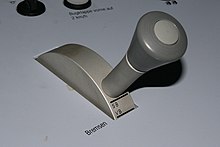Emergency stop


The emergency braking ( ) (including emergency braking ) is the driving dynamics of a motor vehicle, in which taking advantage of all technical possibilities and ignoring of wear or comfort factors, the vehicle maximum delay is.
Emergency braking is usually used to prevent or mitigate accidents . In motorsport , emergency braking to achieve the best test times is a common process.
Since November 1, 2002, emergency braking can be required as one of the basic driving tasks in the practical class B driving test in Germany. Officially, this basic driving task is called "braking with the greatest possible deceleration". Full braking is carried out on the open road at approx. 40 km / h. It is not up to the examinee to secure the traffic behind, as this would not be possible in a dangerous situation (e.g. a pedestrian enters the lane ). Rather, the task is carried out at the instruction of the driving instructor.
In modern cars, emergency braking can be supported by an emergency brake assistant.
The rule of thumb for the braking distance in meters for emergency braking of a car is:
Motor vehicles must achieve a braking deceleration of at least 5.0 m / s 2 , those with a maximum speed of up to 25 km / h one of 3.5 m / s 2 . Until April 1, 2000, only 2.5 m / s 2 and 1.5 m / s 2 were required. For tram vehicles participating in road traffic, a deceleration of at least 1.71 m / s 2 (at 20 km / h) to at least 2.73 m / s 2 (at 70 km / h) has been required since at least 1965 .
Rail transport
Emergency braking is the strongest form of service braking for rail vehicles . It does not cause the greatest possible deceleration as in road traffic; this is the case with rapid braking . Full braking is initiated by moving the driver's brake valve to position VB (for full braking), which lowers the pressure in the main air line from 5 bar to 3.5 bar and increases the pressure in the brake cylinders to around 3.8 bar.
Web links
Individual evidence
- ↑ § 41 (4) StVZO
- ↑ BGBl. 2000 I p. 310
- ↑ BGBl. 1965 I p. 1513
- ↑ BOStrab Annex 2, Table 2
